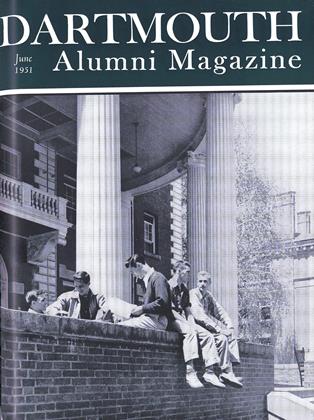GREAT PLAINS, by Alexander B. Klots'25. Published by Houghton Mifflin Co., 1951, 349 pp.,& 3.5.
This delightful book of pocket size is packed with reliable information. Condensed in the introductory 60 pages are facts about butterfly life in general. Habitats of every sort are described, from mountain pastures to salt marshes, from upland forests, prairies and savannahs to mangrove thickets. Glimpses of a few of them are shown by several beautiful photographs; characteristic plants and trees of each are named, with the particular kinds of butterflies likely to be flying among them and growing up upon them.
The major faunal regions of Eastern-Central North America depending upon temperature (and east-west, on rainfall) are described: e.g., six life-zones: from Arctic-Alpine to Subtropical in Florida and Texas, each with its special plants, trees and the associated species of butterflies.
Then follow brief accounts of life-history, behavior, external anatomy, genitalia and colors of butterflies, and brief descriptions of their caterpillars and chrysalids. Two color plates show accurately these two stages in numerous American species.
The main purpose of the book, beyond this concise but comprehensive introduction, is description and portrayal of all species east of the "Great Plains," which are defined as extending eastward from the Rockies as far as 100° west longitude. This convenient line cuts North America rather unequally into halves. Just west of it are the High Plains; just east, the Prairies.
This main part of the book shows beautiful and accurate color paintings of 247 species, and there are many excellent black-white photographs. Each species is called by its "common" English name and by the more precise one in Latin. The "range" of each, its food plants and caterpillar are described. To help in identification, distinctive color markings of the butterfly are sharply pointed out on the 32 plates; and similar species which might be mistaken for it are noted.
The author has personally explored the extensive regions covered in this book and studied the butterflies alive. He began to observe and collect them about three years be-fore he entered Dartmouth. Graduating in 1925 at Cornell, he soon became a member of the Faculty of New York City College, and continued to carry on research at the American Museum of Natural History. His chapter
"Advice to Teachers" is admirable. In this distinguished book, experienced lepidopterists are informed of the latest discoveries in their specialty, while young folks are taught how to begin and carry on what will become to them a fascinating hobby.
 View Full Issue
View Full Issue
More From This Issue
-
 Class Notes
Class Notes1949
June 1951 By ROBERT H. ZEISER, DAVID S. VOGELS JR., JOHN F. STOCKWELL -
 Class Notes
Class Notes1918
June 1951 By ERNEST H. EARLEY, DONALD L. BARS, RICHARD A. HOLTON -
 Class Notes
Class Notes1929
June 1951 By F. WILLIAM ANDRES, EDWIN C. CHINLUND, GEORGE B. REDDING -
 Article
ArticleThe Senior Fellowships
June 1951 By EDWARD C. LATHEM '51 -
 Class Notes
Class Notes1940
June 1951 By ELMER T. BROWNE, DONALD G. RAINIE, FREDERICK L. PORTER -
 Class Notes
Class Notes1943
June 1951 By ELMER G. STEVENS JR., STANTON B. PRIDDY, THEODORE R. HOPPER
Books
-
 Books
BooksAlumni Articles
March 1956 -
 Books
BooksTHE MOUNTAIN MEN.
MARCH 1964 By ALLEN R. FOLEY '20 -
 Books
BooksINTERVIEWS WITH ROBERT FROST.
NOVEMBER 1966 By C.E.W. -
 Books
BooksCOLLEGE CHEMISTRY.
November 1956 By HENRY H. BAKER, JR. '29 -
 Books
BooksHOW TO CATCH A CROCODILE.
MARCH 1965 By R. J. B. -
 Books
BooksTHE POETRY OF ROBERT FROST.
MARCH 1970 By STEARNS MORSE, A.M. '36


